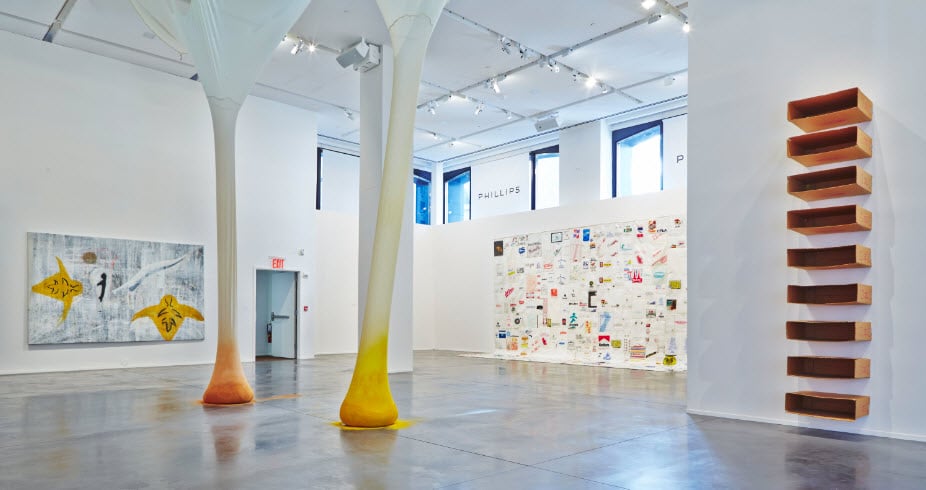
Kaelie Deane in front of Ene Eme y Ene De by Roberto Obregón (1994).
Phillips is one of the top auction houses exploring the frontier of contemporary art and design work in the market. Kaeli Dean, head of sale at Phillips, offers her fresh insight into the rapidly changing Latin American art market, and how older artists are only now entering the spotlight.
Phillips’ upcoming Latin America sale takes place tomorrow on Wednesday, November 18, and Kaeli Dean explains how it all came together.
Tell us about your background in art and what led you here.
Before entering the auction world, I studied Latin American art history and Spanish, followed by almost five years at Mary-Anne Martin Fine Art in New York. Working with a dealer of that stature was the best education I could have in this field. At the gallery I worked mostly with Modern painting and sculpture, which built up my historical knowledge of the subject and allowed me an incredible hands-on experience with museum-quality art. This created a smooth transition into the more contemporary market at Phillips, where I have been able to broaden my understanding of how this exciting market continues to shift and grow.
What do you need to be a good dealer?
For me, honesty and integrity are foremost characteristics one needs for true success in this field. It’s essential to build trust with your clients if you want to have a long term relationship and any chance of selling the best art in the field. Of course, it goes without saying that you have to be an expert in your area as well. For me, this means traveling and seeing as much art as possible. Researching artists is of the upmost importance, but I believe we are far too often stuck behind a screen and it’s vital to get out and see art in person as often as you can.
The 2014 Latin America sale install. Courtesy of Phillips New York.
How do you feel before a sale? Do you have any pre-sale rituals?
This is only my third sale working at Phillips, so honestly I still get really nervous and excited before each sale. The amount of time, passion, and effort that goes into putting a sale together is astonishing. Our team works tirelessly to build a sale that will be unique and break boundaries each season. Pre-sale rituals involve very little sleep and lots of coffee, if you can call that a ritual. And always a post-sale tequila with my colleagues to celebrate our efforts!
Wifredo Lam, Présages (1947). Courtesy of Phillips New York.
What is the highest-selling lot you’ve ever had?
In May 2015, we sold an incredible painting by Wifredo Lam, Présages (1947), for $2,629,000. This was the highest-value artwork ever sold by my department at Phillips, and also our first major work by the artist to hit the auction block. It was a monumental success, helping us break into the Modern picture market, as we have typically been known for our success with contemporary Latin American art.
What was your proudest consignment in the last year?
My proudest consignment is a picture we have coming up at auction in our next sale. The painting is a 1965 work by Carmen Herrera, Basque, that has been in the same collection since it was purchased at Rastovski Gallery in the late 1980s. Herrera, a Cuban artist who has lived in New York since 1954 and just turned 100, has only recently begun to receive the attention she deserves. She has a retrospective opening at the Whitney next year, so to unearth a painting of this importance at this moment is incredibly exciting.
Carmen Herrera, Basque (1965). Courtesy of Phillips New York.
When is your next important sale? Why should we come?
Our next sale takes place on November 18, so it’s coming up fast! This is department’s 11th sale and arguably our best to date because of the quality of consignments. This is the first time in history that a Latin American art department has had a living female artist on both the front and back cover of the catalogue, so to me that is something not to be missed. To be able to show masterpieces by Doris Salcedo and Beatriz Milhazes in the same sale is a historical moment.
Bids are increasingly from all corners of the world. What can you say about this trend?
What is exciting to me is to see how the Latin American market is changing. It used to be that traditionally Mexicans collected Mexican art, Cubans collected Cuban art, and so on. Now we are seeing an increased range of countries represented in Latin American art collections. Not only do we have a huge percentage of Americans collecting in the field, but we are seeing collectors all over the world looking at regions that were traditionally underrepresented, such as Costa Rica, Peru, and Colombia.
If you could have dinner with any three artists, living or dead, who would you choose?
I would love to have dinner with Diego Rivera, Tunga, and Carmen Herrera, but maybe not all at the same time!